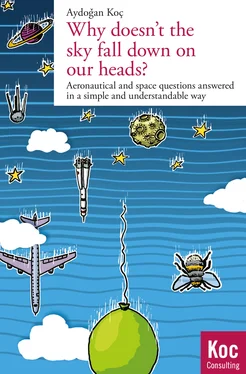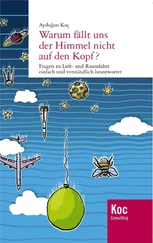Aydogan Koc - Why doesn't the sky fall down on our heads?
Здесь есть возможность читать онлайн «Aydogan Koc - Why doesn't the sky fall down on our heads?» — ознакомительный отрывок электронной книги совершенно бесплатно, а после прочтения отрывка купить полную версию. В некоторых случаях можно слушать аудио, скачать через торрент в формате fb2 и присутствует краткое содержание. Жанр: unrecognised, на немецком языке. Описание произведения, (предисловие) а так же отзывы посетителей доступны на портале библиотеки ЛибКат.
- Название:Why doesn't the sky fall down on our heads?
- Автор:
- Жанр:
- Год:неизвестен
- ISBN:нет данных
- Рейтинг книги:4 / 5. Голосов: 1
-
Избранное:Добавить в избранное
- Отзывы:
-
Ваша оценка:
- 80
- 1
- 2
- 3
- 4
- 5
Why doesn't the sky fall down on our heads?: краткое содержание, описание и аннотация
Предлагаем к чтению аннотацию, описание, краткое содержание или предисловие (зависит от того, что написал сам автор книги «Why doesn't the sky fall down on our heads?»). Если вы не нашли необходимую информацию о книге — напишите в комментариях, мы постараемся отыскать её.
How does lift arise?
What is a Sonic boom?
How does a propeller work?
Why do migratory birds fly in V formations?
Why do airplanes fly so high?
Aerospace is full of mystery!
Aeronautical and space questions answered in a simple and understandable way!
Why doesn't the sky fall down on our heads? — читать онлайн ознакомительный отрывок
Ниже представлен текст книги, разбитый по страницам. Система сохранения места последней прочитанной страницы, позволяет с удобством читать онлайн бесплатно книгу «Why doesn't the sky fall down on our heads?», без необходимости каждый раз заново искать на чём Вы остановились. Поставьте закладку, и сможете в любой момент перейти на страницу, на которой закончили чтение.
Интервал:
Закладка:
Significant aircraft industry did not exist in any of the powerful states in Europe when World War I began. However, it soon became clear that an aircraft could be used as a powerful weapon and proved to be very effective at war. In the beginning, pilots used to fly over enemy lines and manually throw bombs from their cabins. The maneuverability and high altitude of these aircraft were enough to challenge the range of the weapons of the other side.
Significant technical developments were made during the war years. Especially the development of lightweight and powerful aircraft engines started a new era in aviation. By the end of World War I, the total number of aircraft manufactured exceeded 200,000; 48,000 of them being made in Germany and 60,000 in France.
When was the first passenger aircraft built?
When World War I ended in 1918, many countries were left with thousands of aircraft and unemployed pilots. This capacity triggered the idea of cargo, passenger and mail transport. However, the aircraft and equipment available were insufficient for public transport. Limited usable area in the hold and the short range of aircraft made it clear that new solutions were required to replace former warplanes. Therefore, larger aircraft with double or triple engines were developed. The triple engine Junkers G23/24 aircraft, developed in Germany, is the first standard passenger aircraft which opened a new epoch in public transport. This was an advanced version of the Junkers F13, the first aircraft with metal structure and coverings. In previous aircraft models, the main construction material was varnished canvas, wood and hundreds of stretched wire cables.
Who flew over the Atlantic Ocean non-stop for the first time?
The Atlantic Ocean was crossed non-stop with an airplane for the first time in 1919. British war veterans John Alcock and Arthur Witten Brown managed to fly over the Atlantic Ocean with a Vickers Vimy type double decker aircraft on 14 - 15 May, 1919. They departed from Newfoundland and their flight ended with a crash landing in Ireland. Luckily, the pilots survived this emergency landing. They were awarded for their achievement and announced noblemen.
Another important milestone in civil aviation is the nonstop flight of Charles Lindbergh over the Atlantic Ocean from New York to Paris. He crossed the Atlantic Ocean alone in a 36 hour flight with the aircraft “Spirit of St. Louis” on 20 - 21 May, 1927. The average speed of this heroic flight was around 200 km/h.
Which passenger aircraft has been manufactured the most until now?
When the Douglas DC-3 Dakota aircraft was put into service, airlines started to make good profits from passenger transport. 13,000 DC-3s were manufactured which is the largest number of aircraft of one type produced until now. The success of this aircraft was mainly due to the following innovations implemented in the DC-3:
Flaps for Take-off and landing
Retractable landing gear
Low air resistance engine covers
Passenger capacity for over 20 people
Variable pitch Propellers
Automatic 3 axis flight control system
How did defense requirements before World War 2 affect the development of aircraft?
Developments on aircraft gained momentum after the National Socialists came to rule in Germany in 1933. Nazis were determined to become the most powerful military power in the world by 1938. Therefore, they started to make significant investments to advance military aviation. The German Air Force was established in 1935 and, by 1939, managed to be the most powerful air force in the world.
Many developments were achieved with bomber and fighter aircraft types during the Second World War, including:
Increased engine power
Advanced autopilot systems
Pressurized cabins
Advanced ejection seats
Introduction of radar systems
Another development was the first flight of a jet powered warplane, the Heinkel He-178 in 1939. It was possible to achieve much higher speeds with this engine. It was soon discovered that high speed presented many new problems. For example, as the aircraft gets close to the speed of sound, the air resistance increases significantly. The concept of the "sound barrier" started to be discussed. Aerodynamic specialists developed arrow head wings and managed to reduce the resistance when approaching the speed of sound.
How it came to the development of large passenger aircrafts?
Strategic needs during World War 2 led to increased dimensions of bombardment and transport aircraft. After the war, this trend continued in the USA. The six engine Boeing B-47 “Stratojet” military aircraft made its first flight in 1950 in the USA. With a speed of over 950 km/h, this aircraft reached an altitude of 12,300 m and left other fighter planes behind.
An advanced model of this aircraft, the strategic bomber aircraft B-52 “Stratofortress” exceeded 960 km/h and rose to 16,700 m. With these speed and range capabilities, the B-52 remained the most capable and efficient bomber aircraft of the western world for a long time.
The "Comet", the first jet powered passenger plane manufactured by British De Havilland in 1949 completed its test flights and started passenger service in 1952. This aircraft, which gained a bad reputation due to several accidents because the cabin structure was not designed for the pressures at high altitude, was completely withdrawn from service in 1954. In 1959, a brand new and safe model of the aircraft with all the problems solved was put on the market. But the opportunity to control the market was lost. In the meantime, the USA was planning military purpose jet powered transport aircraft parallel to Europe. A civil aviation version of the KC135 tanker plane, which resulted from these projects, was manufactured: the Boeing-707. This popular passenger aircraft made its first flight on 15 July, 1954. The secret to success of the Boeing-707, which conquered the passenger plane market, was its better technical performance compared to its closest rival, the DC-8 by Douglas; and the improved British Comet was not yet ready for the market.
Also known as “Jumbo-Jet”, the large body passenger plane Boeing-747 was a side product of another military project. This passenger plane, designed by Boeing to carry military loads, flew for the first time in 1969. When the military project was awarded to Lockheed for the C-5 “Galaxy”, Boeing quickly transformed its proposed design into the 747 passenger aircraft. Boeing strengthened its market position further towards the end of the 60s by expanding its passenger aircraft family with the medium range Boeing-727 and the short range Boeing-737 aircraft. During this period, the short range French Caravelle aircraft were also very successful in Europe. Plus, the Douglas Aircraft Company emerged as a competitor in the medium range passenger aircraft market with the DC-9 patterned after the Caravelle. In the 70s, other aircraft joined the fleet of wide body passenger aircraft initiated by Boeing. These are the DC-10 by Douglas in 1971, the Lockheed-1011 Tristar in 1972 and the European Airbus A-300 in 1972.
Today, aircraft designer’s main goals are to be ecological, consume less fuel and carry as many passengers as possible.
When was the sound barrier broken for the first time?
Military aviation chose a slightly different path from civil aviation after World War 2. The specifications for military aircraft were high acceleration and superior maneuverability at very high altitude and very high speed.
The rocket powered aircraft, Bell X-1, was the first aircraft to break through the sound barrier in 1947. Thereafter, the research aircraft X-15 reached 7,200 km/h and rose to 108 km altitude between 1959 and 1968. All these operations at “higher speed and higher altitude” also affected the civil aviation sector. The supersonic passenger aircraft "Corcorde", a joint production of Britain and France, made its first flight in Toulouse in the south of France in 1969. A Concorde was the first passenger plane to break the sound barrier with a speed of 2,200 km/h. For this speed, which was twice the speed of sound, Concorde needed to fly at an altitude of 16 to 18 km. The excessive fuel consumption and limited number of passengers prevented the Concorde from becoming a success. Only 16 aircraft were produced and included in French and British national airline fleets. Yet, it was in service cruising at twice the speed of sound, in intercontinental travel between 1976 and 2003. The only rival of the “Concorde” was from the east block by the Russian made Tupolev TU-144. Although it was not as successful as Concorde, this aircraft made about 100 flights in the Siberian sky and then was removed from the Aeroflot fleet in 1983.
Читать дальшеИнтервал:
Закладка:
Похожие книги на «Why doesn't the sky fall down on our heads?»
Представляем Вашему вниманию похожие книги на «Why doesn't the sky fall down on our heads?» списком для выбора. Мы отобрали схожую по названию и смыслу литературу в надежде предоставить читателям больше вариантов отыскать новые, интересные, ещё непрочитанные произведения.
Обсуждение, отзывы о книге «Why doesn't the sky fall down on our heads?» и просто собственные мнения читателей. Оставьте ваши комментарии, напишите, что Вы думаете о произведении, его смысле или главных героях. Укажите что конкретно понравилось, а что нет, и почему Вы так считаете.












